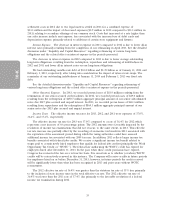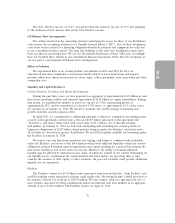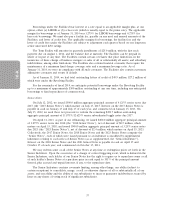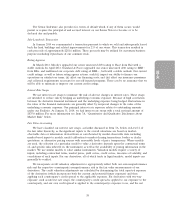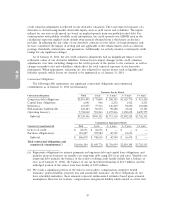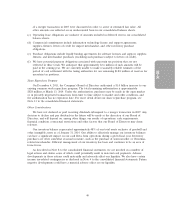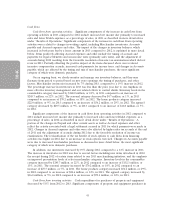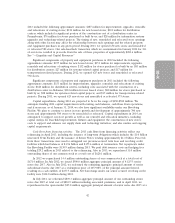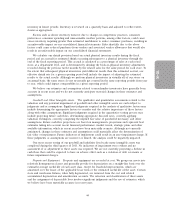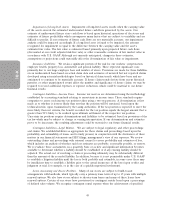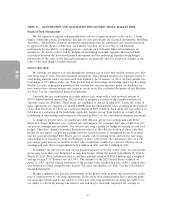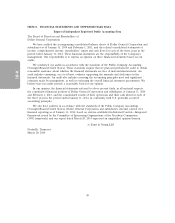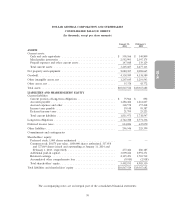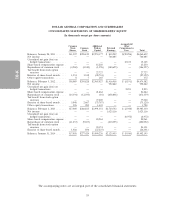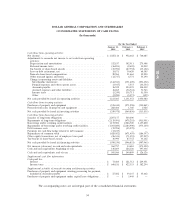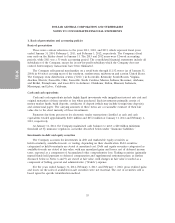Dollar General 2013 Annual Report Download - page 122
Download and view the complete annual report
Please find page 122 of the 2013 Dollar General annual report below. You can navigate through the pages in the report by either clicking on the pages listed below, or by using the keyword search tool below to find specific information within the annual report.
Impairment of Long-lived Assets. Impairment of long-lived assets results when the carrying value
of the assets exceeds the estimated undiscounted future cash flows generated by the assets. Our
estimate of undiscounted future store cash flows is based upon historical operations of the stores and
estimates of future profitability which encompasses many factors that are subject to variability and are
difficult to predict. If our estimates of future cash flows are not materially accurate, our impairment
analysis could be impacted accordingly. If a long-lived asset is found to be impaired, the amount
recognized for impairment is equal to the difference between the carrying value and the asset’s
estimated fair value. The fair value is estimated based primarily upon projected future cash flows
(discounted at our credit adjusted risk-free rate) or other reasonable estimates of fair market value in
accordance with U.S. GAAP. Although not currently anticipated, changes in these estimates,
assumptions or projections could materially affect the determination of fair value or impairment.
Insurance Liabilities. We retain a significant portion of the risk for our workers’ compensation,
employee health, property loss, automobile and general liability. These represent significant costs
primarily due to our large employee base and number of stores. Provisions are made for these liabilities
on an undiscounted basis based on actual claim data and estimates of incurred but not reported claims
developed using actuarial methodologies based on historical claim trends, which have been and are
anticipated to continue to be materially accurate. If future claim trends deviate from recent historical
patterns, or other unanticipated events affect the number and significance of future claims, we may be
required to record additional expenses or expense reductions, which could be material to our future
financial results.
Contingent Liabilities—Income Taxes. Income tax reserves are determined using the methodology
established by accounting standards relating to uncertainty in income taxes. These standards require
companies to assess each income tax position taken using a two-step process. A determination is first
made as to whether it is more likely than not that the position will be sustained, based upon the
technical merits, upon examination by the taxing authorities. If the tax position is expected to meet the
more likely than not criteria, the benefit recorded for the tax position equals the largest amount that is
greater than 50% likely to be realized upon ultimate settlement of the respective tax position.
Uncertain tax positions require determinations and liabilities to be estimated based on provisions of the
tax law which may be subject to change or varying interpretation. If our determinations and estimates
prove to be inaccurate, the resulting adjustments could be material to our future financial results.
Contingent Liabilities—Legal Matters. We are subject to legal, regulatory and other proceedings
and claims. We establish liabilities as appropriate for these claims and proceedings based upon the
probability and estimability of losses and to fairly present, in conjunction with the disclosures of these
matters in our financial statements and SEC filings, management’s view of our exposure. We review
outstanding claims and proceedings with external counsel to assess probability and estimates of loss,
which includes an analysis of whether such loss estimates are probable, reasonably possible, or remote.
We re-evaluate these assessments on a quarterly basis or as new and significant information becomes
available to determine whether a liability should be established or if any existing liability should be
adjusted. The actual cost of resolving a claim or proceeding ultimately may be substantially different
than the amount of the recorded liability. In addition, because it is not permissible under U.S. GAAP
to establish a litigation liability until the loss is both probable and estimable, in some cases there may
be insufficient time to establish a liability prior to the actual incurrence of the loss (upon verdict and
judgment at trial, for example, or in the case of a quickly negotiated settlement).
Lease Accounting and Excess Facilities. Many of our stores are subject to build-to-suit
arrangements with landlords, which typically carry a primary lease term of up to 15 years with multiple
renewal options. We also have stores subject to shorter-term leases and many of these leases have
renewal options. Certain of our stores have provisions for contingent rentals based upon a percentage
of defined sales volume. We recognize contingent rental expense when the achievement of specified
45
10-K


